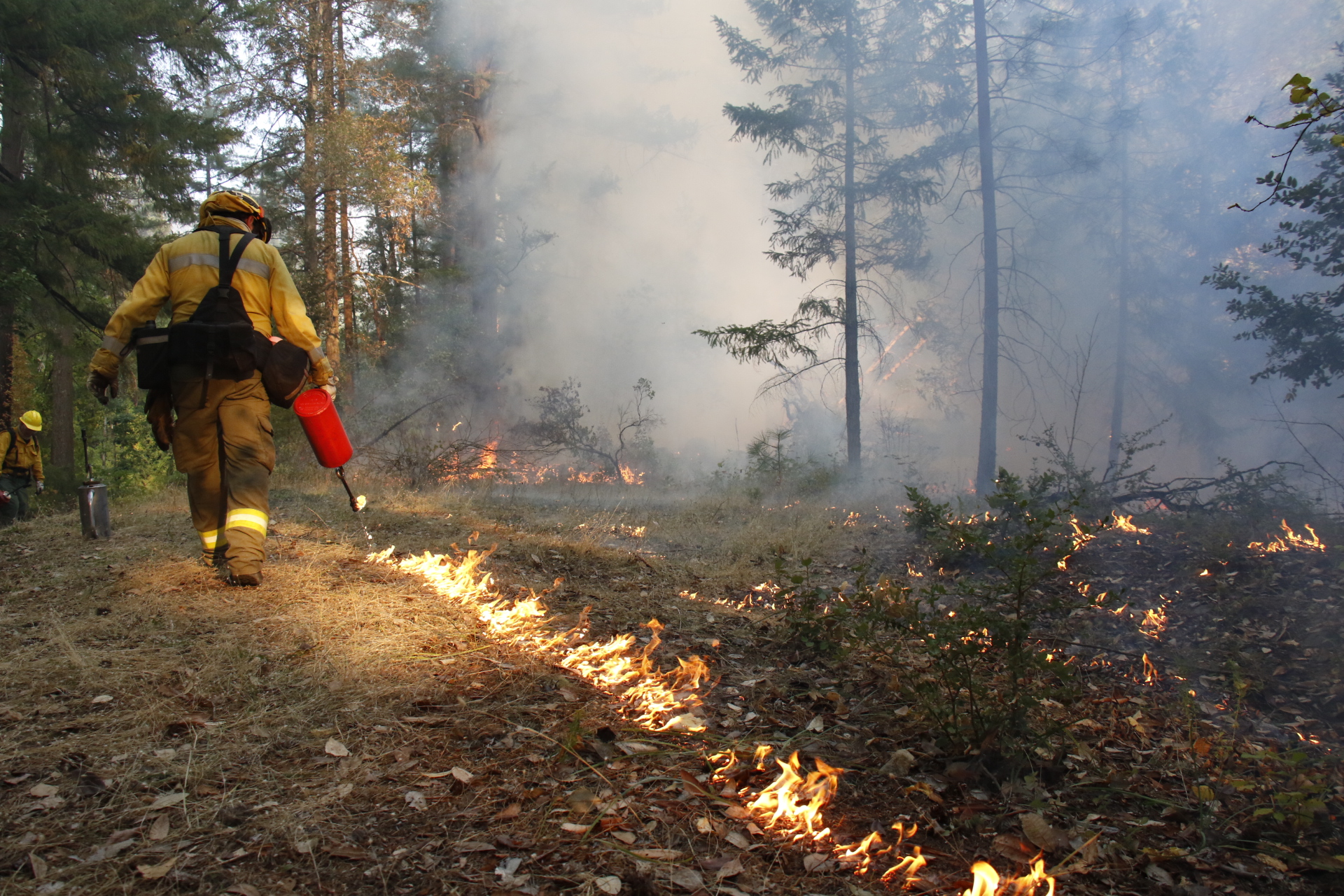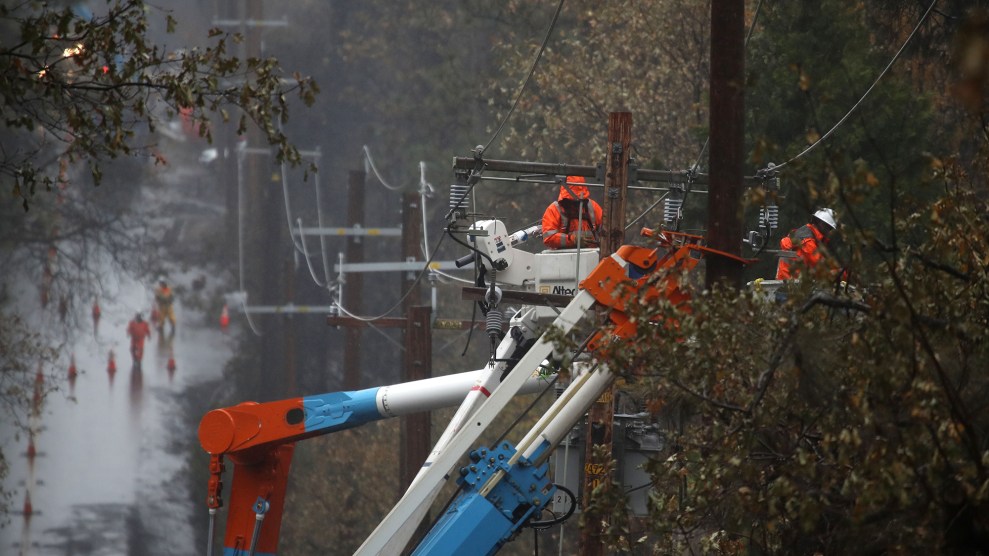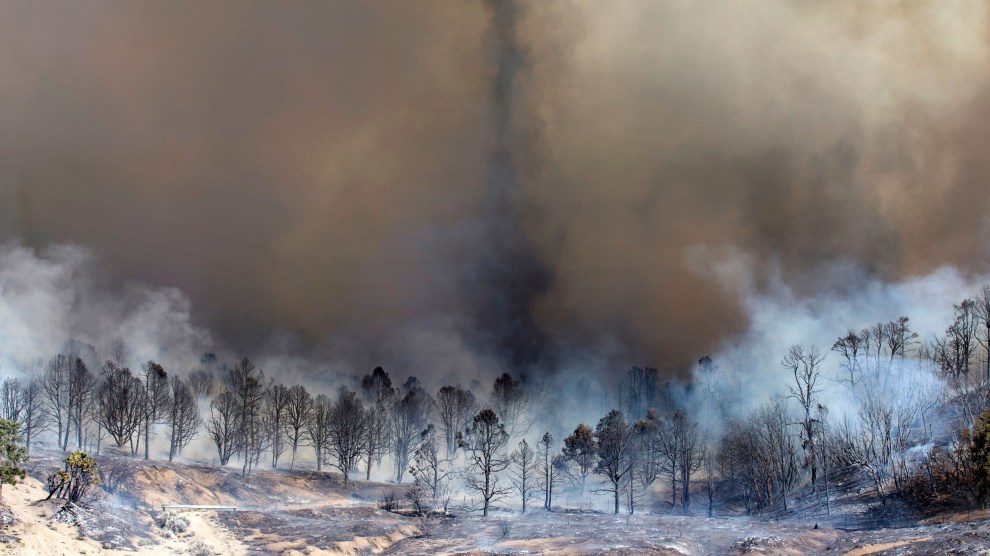When it came time to set fire to the hillside, Kitty Lynch paused. A 70 year-old retired waitress, Lynch’s job during the controlled burn of a 2,200 acre ranch in Humboldt County, California this June was to keep the fire in check by tamping down small, errant flames with a tool called a McLeod. Lynch had been attending lectures by Indigenous tribes in her region about prescribed fires, blazes lit intentionally to control dry brush and prevent unplanned burns, for over a decade. But she was the oldest person in this group of about fifty, and she worried she wouldn’t be able to keep up.
The effort was organized by the Humboldt County Prescribed Burn Association, a grassroots team of wildfire experts, local landowners and community members that hosts hands-on trainings on controlled burns as a method of natural disaster prevention. The Humboldt event united unlikely allies: Trump-supporting ranchers worked side-by-side with retired hippies and back-to-the landers; logging workers hammed it up with the same Save the Redwoods League activists they battled in the region’s timber wars. Academics who studied prescribed burning watched their theory become practice.
Lynch’s worries were quickly put to rest. The organizers were “very welcoming, and [found] a place for everyone,” she told me on a recent call. Timed for a clear, sunny day with low wind and moderate humidity, the burn successfully cleared medusahead, an invasive grass, from 50 acres of the ranch. “I’m a firm believer in the results [prescribed fire] produces,” said Lynch, “and it’s wonderful to see the whole age spectrum of dedicated people in the community helping.”
Controlled burns like these are becoming more common across the West and especially in California, where uncontrolled blazes have forced the evacuation of over 300,000 people and scorched about 200,000 acres so far this year. As legislators and regulators grapple with how to prevent destructive wildfires and keep the state’s largest energy utility in check, scientists, land management groups, and advocates are pushing another method: fighting fire with fire.
The idea isn’t new. For countless generations, Indigenous people have worked with fire to maintain healthy landscapes that are less prone to massive wildfires. While allowing natural fires to burn, Native Americans in California and elsewhere started some intentionally to clear dry brush, maintain species balance, and create prairies and meadows where animals graze. In the early days of Western settlement, some ranchers also adopted this practice to maintain pastureland for cattle.
But in the 1880’s, the US Army began to administer Yellowstone, the first national park, and developed the idea of “fighting” fire. In 1910, wildfires in Idaho and Montana burned millions of acres, destroying communities and killing 86 people. The US Forest Service subsequently adopted a policy of putting out all blazes, which state and federal land management agencies mimicked in an effort to protect timber supplies and human lives. Under these policies, Indigenous people and ranchers alike could be fined for burning their own lands.
In 1968, the National Park Service lifted its fire ban after noticing a decline in giant sequoia trees, which depend on fire to grow. Over the next fifteen years, the Forest Service and the California Department of Forestry and Fire Protection (Cal Fire) gradually re-introduced fire to their landscapes. The Forest Service now admits that suppression backfired; excluding fire created an unnatural build-up of dry brush and overcrowding of trees that’s partly fueling today’s mega-fires. Scientists and policy makers increasingly agree that under the right conditions, intentionally burning away flammable vegetation is one of the most effective tools for reducing wildfire risk. And research shows that when wildfires do reach lands thinned by prescribed fire, far fewer trees die “even under extreme fire weather,” an effect that can last for up to 15-20 years.
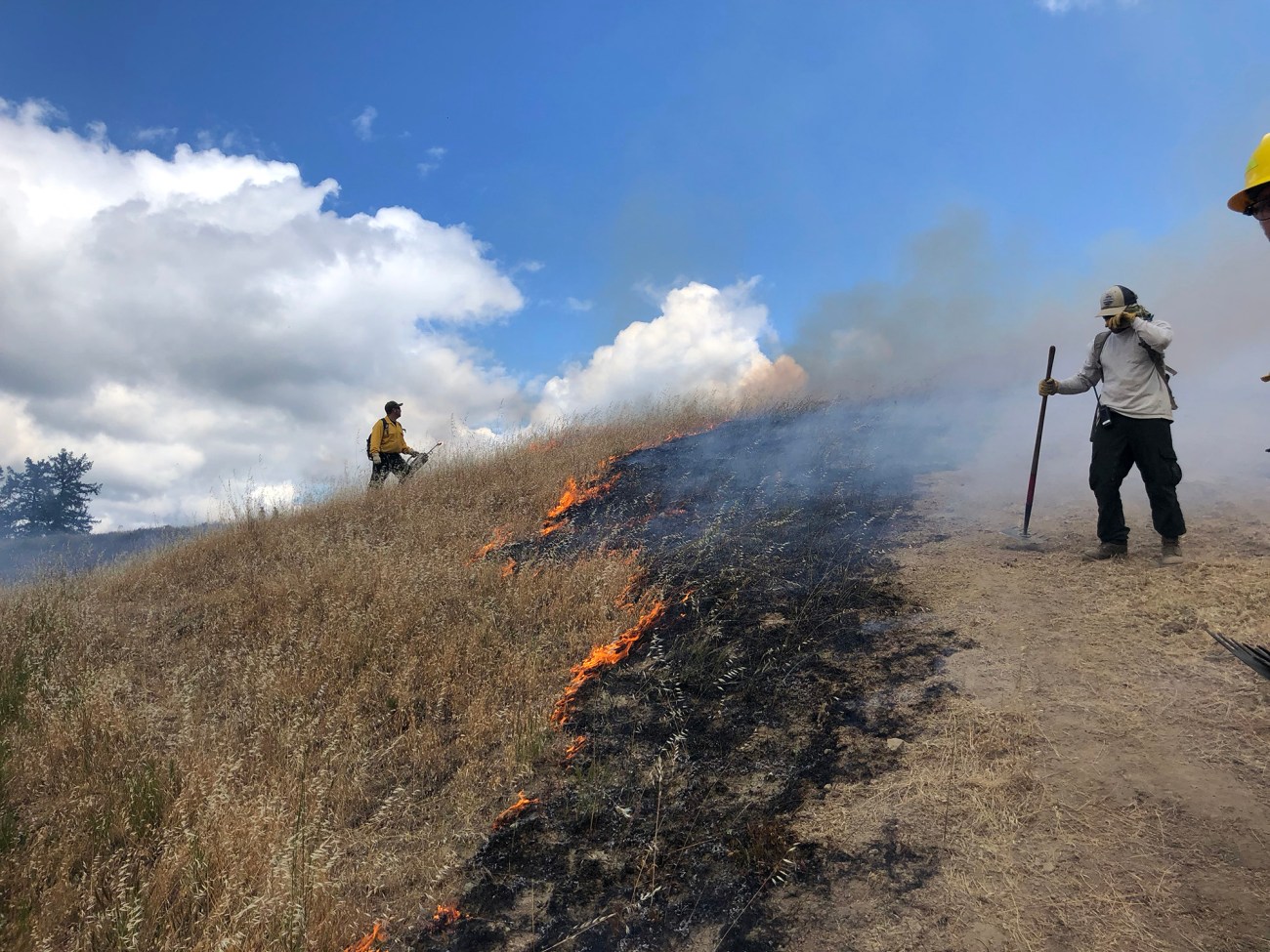
Community members watch the fire line on a controlled burn started by the Humboldt County Prescribed Burn Association.
Lenya Quinn-Davidson
Yet we still have a long way to go. A recent analysis of government data titled “We’re Not Doing Enough Prescribed Fire in the Western United States to Mitigate Wildfire Risk,” written by University of Idaho fire scientist Crystal Kolden, found that between 1998 and 2018, the amount of prescribed burning in the Western US remained stable and even decreased in some areas. According to the Sacramento Bee, fewer than 90,000 acres of California were intentionally burned in 2018. Kolden roughly estimates that the state should be burning at least five times that amount.
“There is an urgency,” Kolden says. “We are seeing every single year now, highly destructive and sometimes fatal wildfires. A lot of the solutions,” like retrofitting buildings or restructuring communities, “take a lot of time and a lot of money. [But] prescribed fire is much cheaper. It ends up being this thing that we can do now, if we have the political willpower.”
Part of the problem is the slow process of obtaining the necessary permits to burn on public lands, which make up about half the state’s acreage. Jake Hannan, a Cal Fire battalion chief, told me that burns can take up to 18 months to plan. The process is much easier for private landowners, who can can burn without permits if Cal Fire approves of their experience and methods. Even during the driest months, local Air Quality districts can grant permits for the smoke that results from prescribed fire on private lands. That’s why burns like the one Lynch worked on are emerging as a solution to the West’s wildfire problem.
“We aren’t anywhere near bringing fire back at the scale we need to,” says Lenya Quinn-Davidson, a fire advisor with the University of California Cooperative Extension who helped lead that burn. “It’s important to push forward with a grassroots model that empowers people to do the work, instead of having bottlenecks with the agency that’s in charge.”
The Humboldt County Prescribed Burn Association, which Quinn-Davidson leads, was the first organization of its kind in the West when it started in 2018, and has already inspired similar groups to start up in northern California’s Plumas, Nevada, Sonoma, and Mendocino counties. These groups bring landowners and neighbors together to provide the manpower that controlled burns require. Quinn-Davidson says she’s hosted 25 lecture and field-based workshops in the past year to increase people’s comfort with prescribed fire, and in the past two years, she’s led 20 burns on private lands.
“We’re bringing fire back to the people, making it more cooperative and accessible,” she says. When it comes to burning on private lands in the West, “the roadblocks are less at the policy level and more at the experience level.”
In 2013, Quinn-Davidson hosted a controlled burning workshop with the Karuk tribe, which is largely based in Orleans, CA, about 70 miles south of Oregon. Controlled burns are integral to the identity of Karuk and their neighbors, the Yurok, who both live in the northern California mountains amidst millions of trees. Decades of fire exclusion upset a delicate balance that tribes helped maintain; their forests have become monocultures dominated by conifers, instead of the colorful mix of oaks and other hardwoods that would flourish with regular burning. But as interest in prescribed fire grows, the Karuk’s expertise is being tapped to help agencies and individuals learn to work with fire, and to follow seasonal rhythms of when and where to burn.
In October, I attended a controlled burn training hosted by the Karuk in Orleans. More than 100 participants, including local landowners, renters, members of the Forest Service and Cal Fire, plus a fire unit from Spain, gathered for a two-week burn of 216 acres of Karuk ancestral lands that are now privately owned. Two days before I arrived for the training, the tribe had burned dozens of acres in a section of the forest they called the Bullpine Unit. Walking through the site, I noticed that nearly all trees survived, but the forest floor, where one might expect a tangle of brush and bramble, was virtually wiped clear, creating a feeling of spaciousness between the tall pines and firs. The area was dotted with thin plumes of smoke, rising from stumps that still smoldered.
At another burn site, a group dripped flames across a tree-covered hill. Others were patrolling the borders of the fire, while the “burn boss” spoke commands into a radio.
“These places are a lot happier when we’re here,” said Vikki Preston, a cultural resource technician with the Karuk Tribe who grew up observing burns and has participated in multiple trainings. “The trees are healthy when we’re tending to them, taking really good care of them.” After burns, Karuk schoolchildren take field trips into the forest to gather acorns and materials for basket-weaving, traditional activities made possible by clearing the forest floor.
Preston explained how they’d chosen the correct conditions for this burn. “We were coming off of it being rainy a couple weeks ago, so it had dried out enough that you could tell [the brush and leaf litter] would burn off. But it was moist enough that we’re not threatened by a wildfire imminently.”
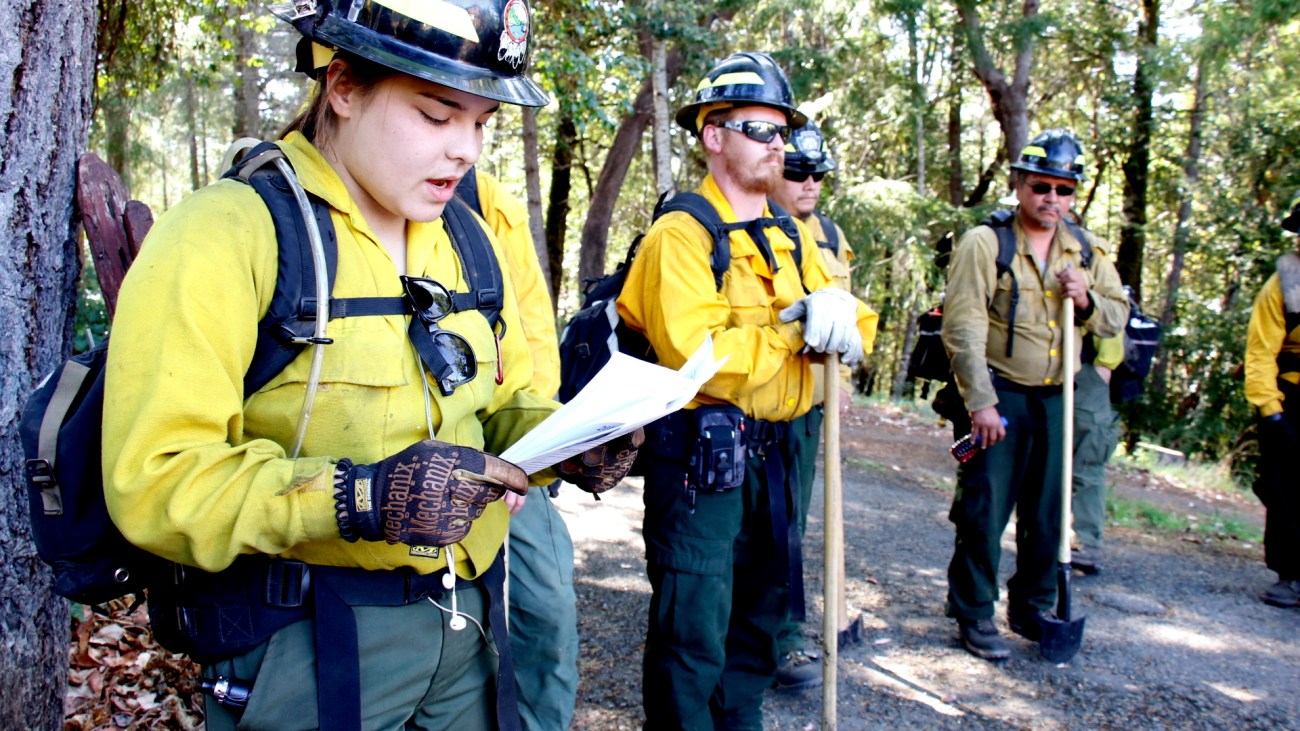
Participants in the Klamath River Prescribed Fire Training Exercise (TREX) review plans for a controlled burn.
Stormy Staats
Yet not everyone is convinced that controlled burns are scaleable. Terry Warlick, a fire battalion chief with the US Forest Service who works in the Mendocino National Forest and attended the Karuk training, was enthusiastic about the “historical fire regime” modeled by tribes. But, he says not all communities will be.
“They don’t like the smoke, they don’t want to see it—until they have to experience a wildfire,” he told me, as volunteers followed the shin-high flames creeping across the hillside. “It kind of seems like we got to go through, you know, an event to change our thought process.”
“People are scared of any fire application,” says Hannan, the Cal Fire chief. “All they’ve known is these huge fires that burn down houses and sometimes kill people.”
He was referring to recent infernos like the Camp and Carr Fires, but prescribed fires occasionally wreak havoc, too. A controlled burn’s “escape” started the 2000 Cerro Grande Fire in New Mexico, which scorched 47,000 acres and left 400 families homeless. Such incidents can be almost completely prevented, says Preston, by fire crews that have intimate knowledge of the lands they are burning, and follow specific techniques.
After starting a burn, experts from her tribe work with local agencies to monitor it. “All day they’re taking data,” she says, to glean a solid projection of where the fire is headed. When a fire has lingered for too long, or threatens to move past the fire line, crews can spray water or use tools to tamp it down. But under the right conditions—low wind, high humidity—it usually flickers out on its own.
Cal Fire is slowly increasing its prescribed fire targets. By the end of this fiscal year, they intend to burn 25,000 acres, while the Forest Service in California burned 43,000 acres over the past fiscal year. Independent training exercises like the Karuk’s burned about 14,000 acres nationwide in 2018, and over 125,000 in the past decade.
Preston and other Karuk tribal members, in line with scientific consensus, believe there should be more prescribed fire throughout the year. The tribe’s plans for this year’s training burns were limited by a “burn ban” imposed all summer and reinstated this fall due to high winds and low humidity across most of California, the same conditions that prompted the utility company Pacific Gas & Electric to shut off power lines across the state, leaving millions without electricity. Yet Preston and others say the conditions in the mountainous region of Orleans were ideal for burning.
“We should be basing these [burn ban] decisions on local factors and not socio-political factors,” says Bill Tripp, a deputy director in the Karuk Tribe’s Department of Natural Resources, implying that burn bans may be intended to limit liability for utilities like PG&E, or to avoid the negative optics of a planned burn while wildfires wreak havoc elsewhere. “The Forest Service and the local [Cal Fire] unit were with us in saying ‘we know this timing is right,’ but the decision is being made in Sacramento,” where Cal Fire is headquartered. The October moratorium prevented the Karuk from burning about 100 of their 300 intended acres.
“We’re not getting to scale,” says Tripp, who would like to see tens of thousands of acres in the tribe’s region burned. “We’ve got people on hand who are ready and qualified, it’s right on our homelands, and we’ve been doing this for millennia. But as long as we’re relying on someone else to make the decision of when to act, I don’t think we’re gonna get there.”
Some Karuk leaders worry about their burn methods being “co-opted” by groups like the Forest Service, who historically infringed on their ceremonies and stewardship of the land. A 2014 report on ecological sovereignty from the tribe argued that “while non-Tribal agencies have attempted to gain access to Karuk knowledge, a far more effective and appropriate action these agencies can take is to remove the barriers their policies put into place”—in other words, stand aside and let knowledgeable tribes burn.
A spokesperson for Cal Fire says that the statewide agency is not considering any changes to the way it implements bans, though some areas may be granted exemptions, and the permitting process for landowners who want to burn is currently being streamlined.
Yet without the support and education of non-Native communities, loosening state regulations on burning may not do much. “We need strong leadership from the community itself, not coming from the government or Cal Fire, to make the burns successful,” Chief Hannan told me. “The more events that occur in nearby communities, where fires aren’t going out of control, the more accepting people will be.”
In her work training people to safely adopt prescribed burning, Quinn-Davidson finds inspiration in the Karuk approach to fire. “We should be striving for the level of connection and personal reflection that Indigenous cultures have with their landscapes,” she said, describing a holistic mindset that non-Natives may need to learn from to care for lands more sustainably. “We’re in an era when we need to find a meaningful place for everyone to work on this, every kind of community member.” Even a self-proclaimed “inexperienced novice” like Kitty Lynch.
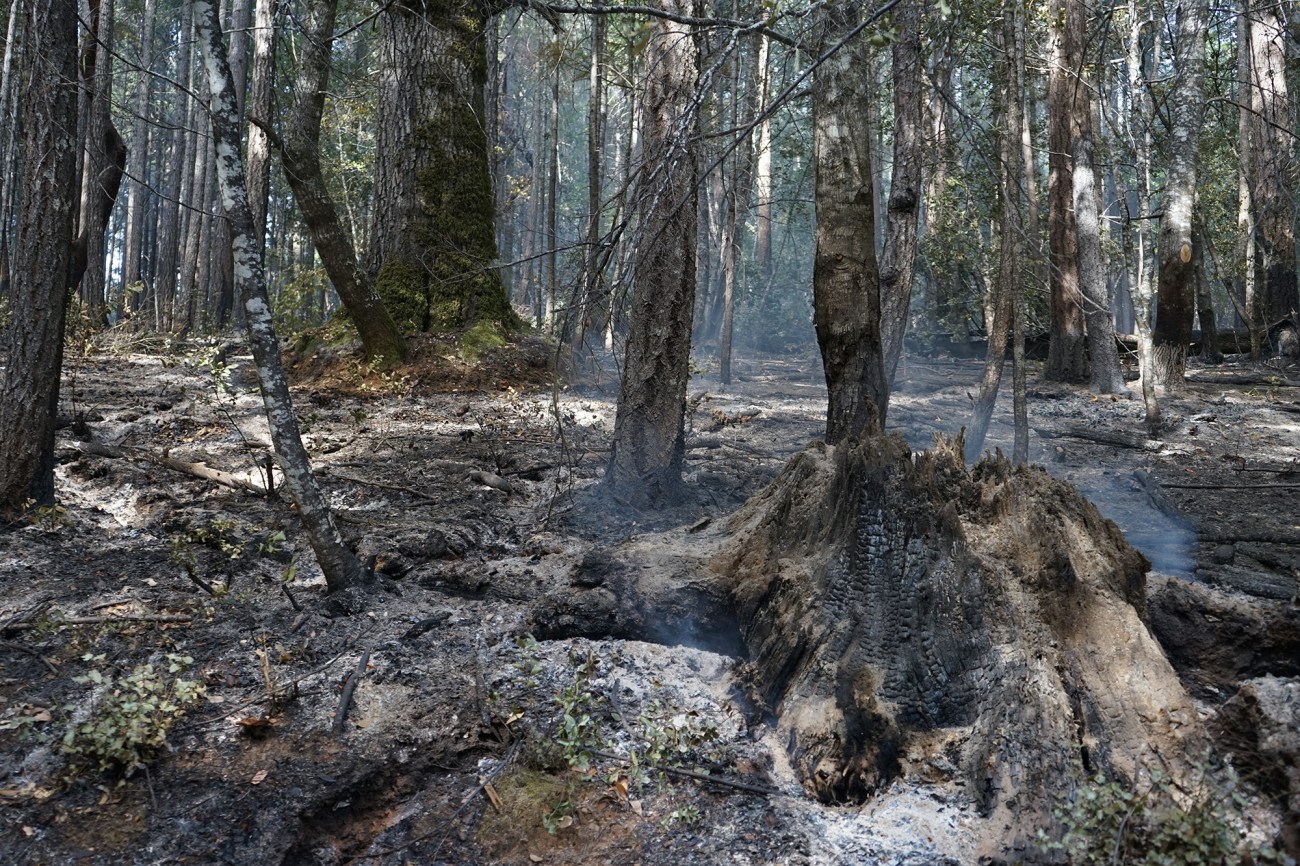
A stump smolders in part of a conifer forest intentionally burned during the Klamath River Prescribed Training Exercise.
Delilah Friedler
